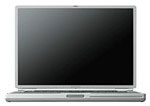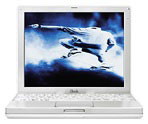At Macworld Expo in January 2001, Steve Jobs unveiled the first Macs
to pass the 500 MHz mark. The 'Digital Audio' Power Mac G4
moved to a 133 MHz system bus. CPU speeds of 466 and 533 MHz were
immediately available; the 667 and 733 MHz models would be out in a
month or so.
These Power Macs used new versions of the G4 processor: the 7410 low
power CPU in the slower models and the high performance 7450 in the
faster ones. They also had one more PCI slot than earlier AGP Power
Macs (at the cost of one bank of memory - 1.5 GB was the maximum RAM in
the Digital Audio models), and all but the slowest model shipped from
the factory with Nvidia GeForce 2 MX graphics cards in the 4x AGP
slot.
Jobs also announced the first DVD burning solution for under $5,000
- the G4/733 includes a SuperDrive that can read and write various CD
and DVD formats, including DVD-R, which can be played back in many
consumer DVD players. Apple's iDVD software, included with the
SuperDrive, made creating DVDs a simple process.
 Speed is nice, but for a lot of Mac
users the high point of the Expo was the new titanium PowerBook G4 (quickly
nicknamed the TiBook). Just one inch thick, the 5.3 pound TiBook
included a "mega-wide" 1152 x 768 pixel screen. The new PowerBook was
available for order immediately and began shipping by the end of
January. Available in 400 and 500 MHz speeds, the TiBook has room for
up to 1 GB of RAM. Low End Mac was one of the first sites to receive
and review the new PowerBook.
Speed is nice, but for a lot of Mac
users the high point of the Expo was the new titanium PowerBook G4 (quickly
nicknamed the TiBook). Just one inch thick, the 5.3 pound TiBook
included a "mega-wide" 1152 x 768 pixel screen. The new PowerBook was
available for order immediately and began shipping by the end of
January. Available in 400 and 500 MHz speeds, the TiBook has room for
up to 1 GB of RAM. Low End Mac was one of the first sites to receive
and review the new PowerBook.
Jobs announced that Mac OS X would be available on March 24 - and
would come installed on new Macs beginning in July.
In other software news, iTunes 1.0 was released.
Flower What?
 Apple dropped the next bombshell in February,
speed-bumping the iMac from 350-500 MHz in 50 MHz steps to a trio of
models at 400, 500, and 600 MHz. The top two models included CD-RW
drives and two new color schemes: Flower Power and Blue Dalmatian.
Throughout the industry, the question was, "What is Apple
thinking?"
Apple dropped the next bombshell in February,
speed-bumping the iMac from 350-500 MHz in 50 MHz steps to a trio of
models at 400, 500, and 600 MHz. The top two models included CD-RW
drives and two new color schemes: Flower Power and Blue Dalmatian.
Throughout the industry, the question was, "What is Apple
thinking?"
February also saw the Power Mac G4 start shipping in 667 and 733 MHz
configurations.
Mac OS X
After years and years of waiting for the "next generation" Mac
operating system, Apple shipped Mac OS X on March 24. The
introduction of OS X 10.1 on Sept. 25 marked a big improvement in
performance and the reintroduction of some "classic" Mac feature. By
the end of the year, OS X had been further updated to version
10.1.2.
New iBooks
 On May 1, Steve Jobs unveiled
the dual USB iBook (a.k.a.
iceBook), which became available mid-May. The new iBook was nearly
2 pounds lighter, measurably smaller, and $200 less expensive than the
older clamshell models - all while bumping speed to 500 MHz, putting
1024 x 768 pixels on a 12.1" screen, and giving the consumer four
different optical drive options: CD-ROM, DVD-ROM, CD-RW, and a
Combo (CD-RW/DVD-ROM) drive.
On May 1, Steve Jobs unveiled
the dual USB iBook (a.k.a.
iceBook), which became available mid-May. The new iBook was nearly
2 pounds lighter, measurably smaller, and $200 less expensive than the
older clamshell models - all while bumping speed to 500 MHz, putting
1024 x 768 pixels on a 12.1" screen, and giving the consumer four
different optical drive options: CD-ROM, DVD-ROM, CD-RW, and a
Combo (CD-RW/DVD-ROM) drive.
The new iBook came in one speed and one color. The only feature
missing compared with the old model was the handle, but it gained a
second (much needed!) USB port. At under five pounds, the missing
handle didn't seem to matter much.
Apple Goes Retail
Apple opened the first two retail Apple Stores on May 15 and had
26 at the end of the year. Today there
are over 200 in the US alone.
New Power Macs
 Apple introduced a new look for the Power Mac
G4 with the release of the
'Quicksilver' models on July 18. The new Power Macs reached a new
level of power with an 867 MHz single CPU model and an 800 MHz dual G4
machine. The 867 MHz Quicksilver is the oldest Mac officially supported
by Mac OS X 10.5 "Leopard".
Apple introduced a new look for the Power Mac
G4 with the release of the
'Quicksilver' models on July 18. The new Power Macs reached a new
level of power with an 867 MHz single CPU model and an 800 MHz dual G4
machine. The 867 MHz Quicksilver is the oldest Mac officially supported
by Mac OS X 10.5 "Leopard".
More New 'Books
On October 16, Apple bumped the iceBook to 600 MHz,
although it left a 500 MHz CD-ROM model in the line as an entry-level
machine. Apple replaced the 400 MHz and 500 MHz Titanium G4 with faster
versions - one at 550
MHz (still on a 100 MHz bus) and the other running at an impressive
667 MHz (on a 133 MHz
bus). These models received one more improvement in December when Apple
made the DVD-ROM/CD-RW Combo drive standard instead of DVD-ROM.
 Enter the
iPod
Enter the
iPod
Apple promoted a special October 23 unveiling as "Not Macintosh",
and hardly anyone had a clue that Apple would introduce a device that
would propel them to the top spot in a market where Apple had no
experience whatsoever.
The first iPod stored 1,000
songs on a tiny 5 GB hard drive in a device that fit into your pocket,
and Mac users didn't quite know what to make of it. It was most
definitely not Macintosh, and it integrated perfectly with Apple's
iTunes software. The original iPod used FireWire to connect and was
only supported on Macs.
Over time the iPod took the industry by storm. Windows support would
be a big part of that equation,but that's a story for another year.
Next - 2002: G4 iMacs, eMac, iPod for Windows,
MDD Power Macs, and Mac OS X 10.2

 Speed is nice, but for a lot of Mac
users the high point of the Expo was the new titanium
Speed is nice, but for a lot of Mac
users the high point of the Expo was the new titanium  Apple dropped the next bombshell in February,
speed-bumping the iMac from 350-500 MHz in 50 MHz steps to a trio of
models at 400, 500, and 600 MHz. The top two models included CD-RW
drives and two new color schemes: Flower Power and Blue Dalmatian.
Throughout the industry, the question was, "What is Apple
thinking?"
Apple dropped the next bombshell in February,
speed-bumping the iMac from 350-500 MHz in 50 MHz steps to a trio of
models at 400, 500, and 600 MHz. The top two models included CD-RW
drives and two new color schemes: Flower Power and Blue Dalmatian.
Throughout the industry, the question was, "What is Apple
thinking?" On May 1, Steve Jobs unveiled
On May 1, Steve Jobs unveiled
 Apple introduced a new look for the Power Mac
G4 with the release of
Apple introduced a new look for the Power Mac
G4 with the release of  Enter the
iPod
Enter the
iPod
